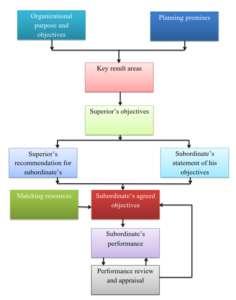6. Management by Objectives
Management by objectives is a technique and system which helps in improving organizational performance. It is both a philosophy and an approach of management. Its basic idea has been derived from the concept of participative goal setting as a technique of OD. The term MBO was coined by Drucker in 1964 when he emphasized the concept of managing by results. Since then many business and non-business organizations have adopted this in some form or the other.
Definitions
According to George S. Odiorne
Management by objectives can be described as a process whereby the superior and subordinate managers of an organisation jointly identify its common goals, define each individuals major area of responsibility in terms of results expected of him and use those measures as guides for operating the unit and assessing the contribution of each of its member.
According to Chakraborty
MBO is a result centered, non-specialist, operational managerial process for the effective utilization of material, physical and human resources of the organization by integrating the individual with the organsiation and organization with the environment.
According to Koontz, O’Donnell and Weihrich
MBO is a comprehensive managerial system that integrates many key managerial activities in a systematic manner, consciously directed towards the effective and efficient achievement of organizational and individual objectives.
Characteristics/Features
i. MBO is a philosophy or a way of thinking about the management.
ii. MBO is an approach to management with objective orientation as its essence. Approach refers to various tools or techniques used in order to achieve the objective.
iii. MBO lays emphasis upon objectives. Whereas the various techniques of management help in measurement of results in resources, MBO is also concerned with determining what these results and resources should be.
iv. MBO is characterized by the participation of concerned managers in objective setting and performance reviews. Therefore, each manager takes active part in setting objectives for himself and also in evaluating his performance about how he is performing.
v. MBO is periodic review of performance at each level. The performance is reviewed regularly, normally once a year.
vi. MBO has a thrust achieved on the objectives. Therefore it provides guidelines for appropriate systems and procedures. Resources allocation, delegation of authority etc. are determined on the basis of objectives. Similarly, reward and punishment system is attached with the achievement of objectives.
Process
The process of MBO requires rigorous analysis, clarity and balance of objectives and participation of managers with accountability for results. This process has the following steps:
i. Setting of Organizational Purpose and Objectives
The first basic step in MBO is the definition of organizational purpose and objectives. Following questions provides the guidelines for the statement of purpose:
- Why does the organization exist?
- What business are we in?
- What should be our business?
This, in interaction with eternal factors, then determines the long-range strategic objective. Usually, the objective setting starts at the top level of the organization and moves downward to the lowest managerial level.
ii. Key Result Area
Organizational objectives and planning premises together provide the basis for the identification of key result areas (KRAs). KRAs also indicate the present state of an organization’s health and the top management perspective for the future.
Examples of KRAs applicable to most of the business organizations are:
- Profitability
- Market standing
- Innovation
- Productivity
- Worker performance
- Public responsibility
These areas are not same for every organization. They differ from organization to organization, depending upon various internal and external environmental factors.
iii. Setting Subordinate’s Objectives
After the general objectives are set and communicated to the concerned managers, the superiors may proceed to work with subordinates in setting their objectives. Every manager is both superior and subordinate in a managerial hierarchy except the person at the top and at the lowest level. Thus a chain of superior subordinate relationship exists in the organization. The process of objective setting begins with superior’s proposed recommendations for his subordinate’s objectives. In turn, the subordinate states his own objectives as perceived by him. Thereafter, the final objectives for the subordinate are set by the mutual negotiation between superior and subordinate. The chain of objectives continues to the lowest level.
iv. Matching resources with objectives
For the success in MBO objectives should be carefully matched with the available resources, when set objectives indicate that they can be achieved with the existing or planned resources. Availability of resources is an important factor in objective setting because it ensures proper application of resources to achieve the objectives. Superior/s role is important in matching objectives with resources. He has to see the need and economy of allocating resources. Such allocation should be done in consultation with the subordinates.
v. Appraisal
Objectives serve as the standard for measuring the performance of subordinate. The superior is to see whether the subordinate is heading towards achieving the objectives and if not what are the problems and how these problems may be overcome. The main purpose of appraisal is to find out the shortcomings in the working and then to remove them promptly. It ensures that everything goes according to the plan.
vi. Recycling
Though the last step in the MBO process appraisal is used as an input for recycling objectives and other actions, objectives are neither set at the top and communicated to the bottom nor are they set at the bottom and communicated upward. It is a joint process through interaction between superior and subordinates. Hence, what happens at one level may happen at other level also and may affect the whole organization. The outcome of appraisal at eh level may be recycled to see whether the objective have been set properly at the level concerned and also at the next higher level.
The three aspects involved in the process are: objective setting, action planning and performance review. Each of these aspects serves as the basis for next aspect. This cycle and recycle goes on as a continuous process.

